Sea serpent
 A sea serpent from Olaus Magnus's book History of the Northern Peoples (1555). | |
| Grouping | Legendary Creature |
|---|---|
| Sub grouping | Sea monster |
| Other name(s) | Worm, wyrm, cetus |
| Country | Various |
| Habitat | Sea |
A sea serpent or sea dragon is a type of dragon described in various mythologies, most notably Greek (Cetus, Echidna, Hydra, Scylla), Mesopotamian (Tiamat), Hebrew (Leviathan), and Norse (Jörmungandr).
Mythology
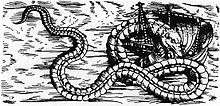
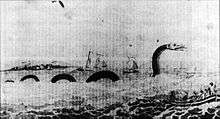

The "Drachenkampf" mytheme, the chief god in the role of the hero slaying a sea serpent, is widespread both in the Ancient Near East and in Indo-European mythology, e.g. Lotan and Hadad, Leviathan and Yahweh, Tiamat and Marduk (see also Labbu, Bašmu, Mušḫuššu), Illuyanka and Tarhunt, etc. The Hebrew Bible also has less mythological descriptions of large sea creatures as part of creation under God's command, such as the Tannin mentioned in Book of Genesis 1:21 and the "great serpent" of Amos 9:3. In the Aeneid, a pair of sea serpents killed Laocoön and his sons when Laocoön argued against bringing the Trojan Horse into Troy.
In antiquity and in the bible, dragons were imagined as huge serpentine monsters, which means that the image of a fire-breathing dragon with four/two legs and wings came much later—in the late Middle Ages; Most of stories say that they live in the sea, the Babylonian myths of Tiamat, the myth of the Hydra, Scylla, Cetus and Echidna in the Greek mythology and maybe even the Leviathan, confirm that.
In Norse mythology, Jörmungandr, or "Midgarðsormr" was a sea serpent so long that it encircled the entire world, Midgard. Some stories report of sailors mistaking its back for a chain of islands. Sea serpents also appear frequently in later Scandinavian folklore, particularly in that of Norway.[1][2]
In 1028 AD, Saint Olaf is said to have killed a sea serpent in Valldal, Norway, throwing its body onto the mountain Syltefjellet. Marks on the mountain are associated with the legend.[3][4] In Swedish ecclesiastic and writer Olaus Magnus's Carta marina, many marine monsters of varied form, including an immense sea serpent, appear. In his 1555 work History of the Northern Peoples, Magnus gives the following description of a Norwegian sea serpent:
Those who sail up along the coast of Norway to trade or to fish, all tell the remarkable story of how a serpent of fearsome size, 200 feet long and 20 feet wide, resides in rifts and caves outside Bergen. On bright summer nights this serpent leaves the caves to eat calves, lambs and pigs, or it fares out to the sea and feeds on sea nettles, crabs and similar marine animals. It has ell-long hair hanging from its neck, sharp black scales and flaming red eyes. It attacks vessels, grabs and swallows people, as it lifts itself up like a column from the water.[5][6]
Notable legends

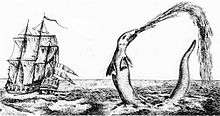

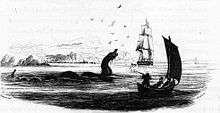
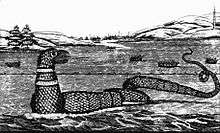

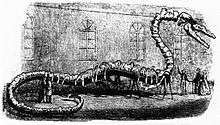

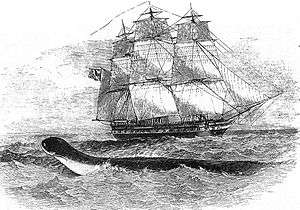
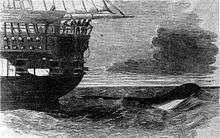
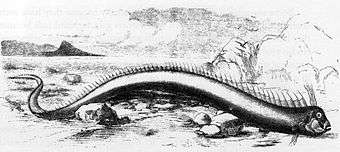
An apparent eye-witness account is found in Aristotle's Historia Animalium. Strabo makes reference to an eye witness account of a dead sea creature sighted by Poseidonius on the coast of the northern Levant. He reports the following: "As for the plains, the first, beginning at the sea, is called Macras, or Macra-Plain. Here, as reported by Poseidonius, was seen the fallen dragon, the corpse of which was about a plethrum [100 feet] in length, and so bulky that horsemen standing by it on either side could not see one another; and its jaws were large enough to admit a man on horseback, and each flake of its horny scales exceeded an oblong shield in length."(Geography, book 16, chapter two, paragraph 17) The creature was seen by Poseidonius, a Philosopher, sometime between 130 and 51 BC.
Hans Egede, the national saint of Greenland, gives an 18th-century description of a sea serpent. On July 6, 1734 his ship sailed past the coast of Greenland when suddenly those on board "saw a most terrible creature, resembling nothing they saw before. The monster lifted its head so high that it seemed to be higher than the crow's nest on the mainmast. The head was small and the body short and wrinkled. The unknown creature was using giant fins which propelled it through the water. Later the sailors saw its tail as well. The monster was longer than our whole ship", wrote Egede. (Mareš, 1997)
See also
References
- ↑ "Sea Serpent?". By Ask.com. Archived from the original on October 25, 2013. Retrieved August 21, 2012.
- ↑ "The Unexplained Mystery of the Sea Serpent". By Crypted Chronicles (March 18, 2012). Retrieved August 21, 2013.
- ↑ "Ormen i Syltefjellet". Archived from the original on 2011-07-24.
- ↑ "Galleri NOR". Nb.no. Retrieved 2014-07-10.
- ↑ "Norse Mythology - Jormungandr". By Oracle Thinkquest. Retrieved August 21, 2013.
- ↑ Water Monsters. Gail B. Stewart (author of the book) of Google Books. Retrieved August 21, 2013.
Further reading
- Lyons, Sherrie Lynne (2010). Species, Serpents, Spirits, and Skulls: Science at the Margins in the Victorian Age. State University of New York Press. ISBN 978-1-4384-2802-4.
External links
| Wikimedia Commons has media related to Sea serpent. |
- Video of the oarfish, a creature that inspired the sea serpent mythology.